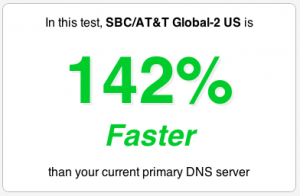 When you go to any website, the browser first has to lookup where that site is located. This is done by connecting to a domain name server (DNS). There are many DNS options, not just the default of the ISP. Often other options are much faster. Most websites actually load content from various domains at once so each DNS request adds up in how fast your internet experience feels.
When you go to any website, the browser first has to lookup where that site is located. This is done by connecting to a domain name server (DNS). There are many DNS options, not just the default of the ISP. Often other options are much faster. Most websites actually load content from various domains at once so each DNS request adds up in how fast your internet experience feels.
A great open-source DNS benchmark utility is namebench. It will test your current DNS against other global DNS or nearby providers. Versions for Windows, Mac, and Linux are available for download.
A recent customer had OpenDNS setup but it turned out the nearby AT&T DNS was 142% faster. Most people probably won’t get quite that huge of a gain. Depending on your location and ISP, its hard to predict what your best DNS option is which is why the namebench utility is so valuable.
Once you’ve figured out your best DNS options, it is best to setup the DNS in your router through its administration page. You could change the DNS in your computer’s network settings, but then none of the other computers on the network would see that gain in internet performance.